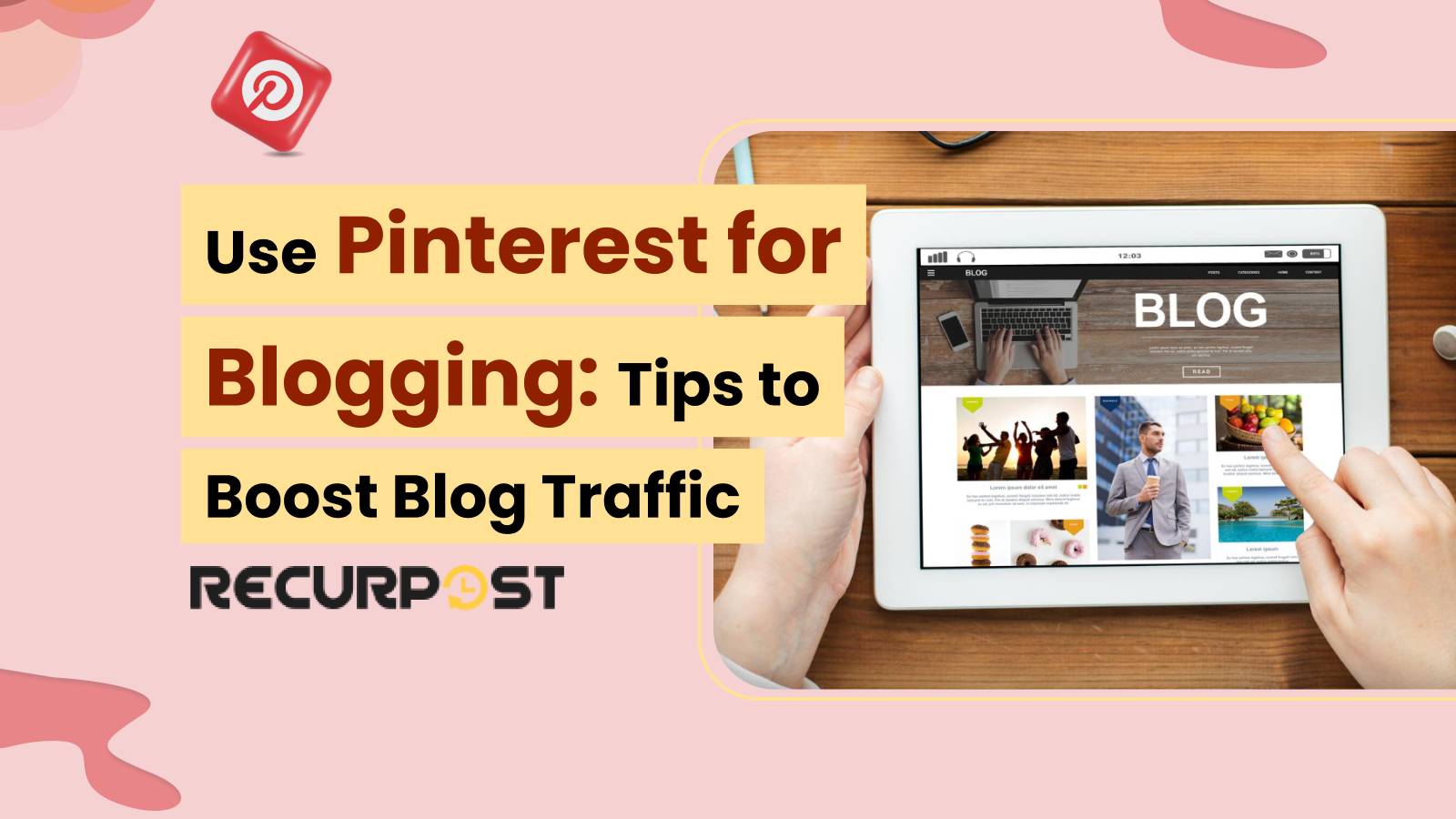Did you know Pinterest for Blogging drives over 400 million active users monthly, with 89% of them seeking inspiration for purchases? (Pinterest) This visual-centric social media platform attracts Pinterest users searching for ideas across countless topics.
While most social media platforms deliver a 24-hour content lifespan, Pinterest pins generate blog traffic for months or even years after publishing. Unlike traditional platforms, Pinterest functions as a visual search engine where content builds momentum over time. Pinterest SEO drives this success. Optimizing pins and boards with relevant keywords naturally improves discoverability that compounds over time.
Setting up a Pinterest business account is your first step toward unlocking these benefits. This guide will walk you through everything you need to make Pinterest for Blogging your blog’s most reliable traffic source in 2025.
1. Understand Pinterest as a Visual Search Engine
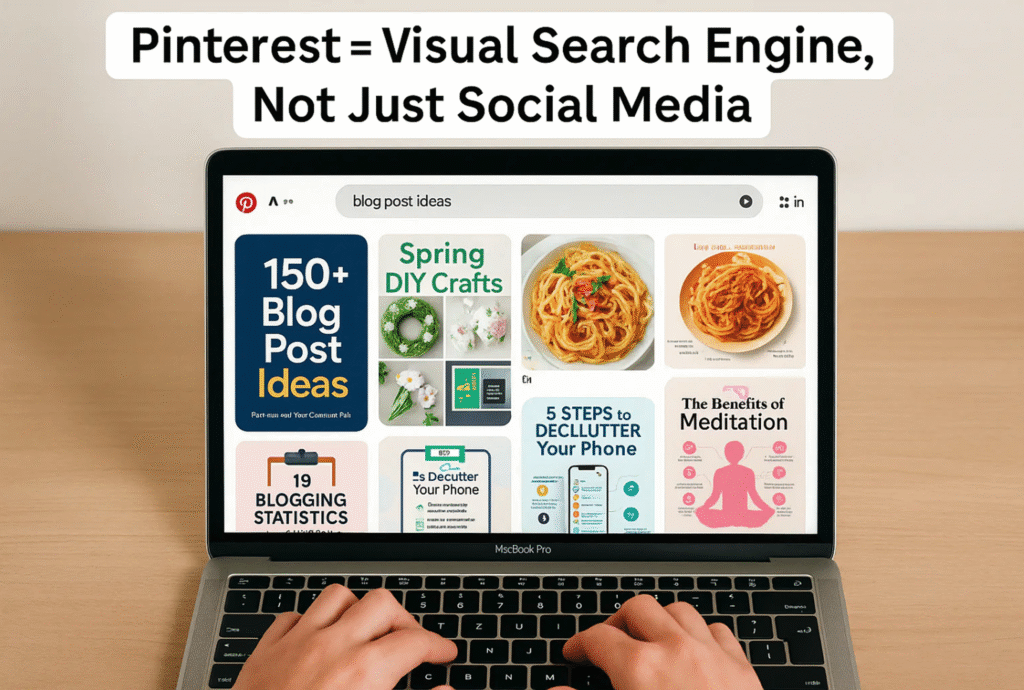
Many bloggers misunderstand Pinterest, treating it as another social media platform. In reality, Pinterest for Blogging works differently: Pinterest functions primarily as a visual search engine where users actively search for ideas, inspiration, and solutions. This fundamental difference explains why traditional blogging strategies often fail when applied to Pinterest for Blogging.
Why is Pinterest different from social media?

Pinterest stands apart from platforms like Instagram or Facebook in several ways. Users don’t visit Pinterest to socialize, comment on posts, or follow friends’ activities. Instead, Pinterest users come with search intent, looking for recipes, DIY tutorials, planning guides, or product recommendations that help them grow blog traffic.
Additionally, Pinterest doesn’t prioritize engagement metrics like likes or comments the way social platforms do. What matters most is how well your pins match what users are searching for. The platform’s algorithm focuses primarily on keyword relevance rather than social signals.
Most tellingly, 96% of searches on Pinterest are unbranded. Users seek ideas and solutions rather than specific companies, creating opportunities for bloggers to be discovered regardless of brand recognition. This discovery-oriented environment makes Pinterest essentially a visual version of Google for specific niches.
Pinterest Demographics and User Behavior
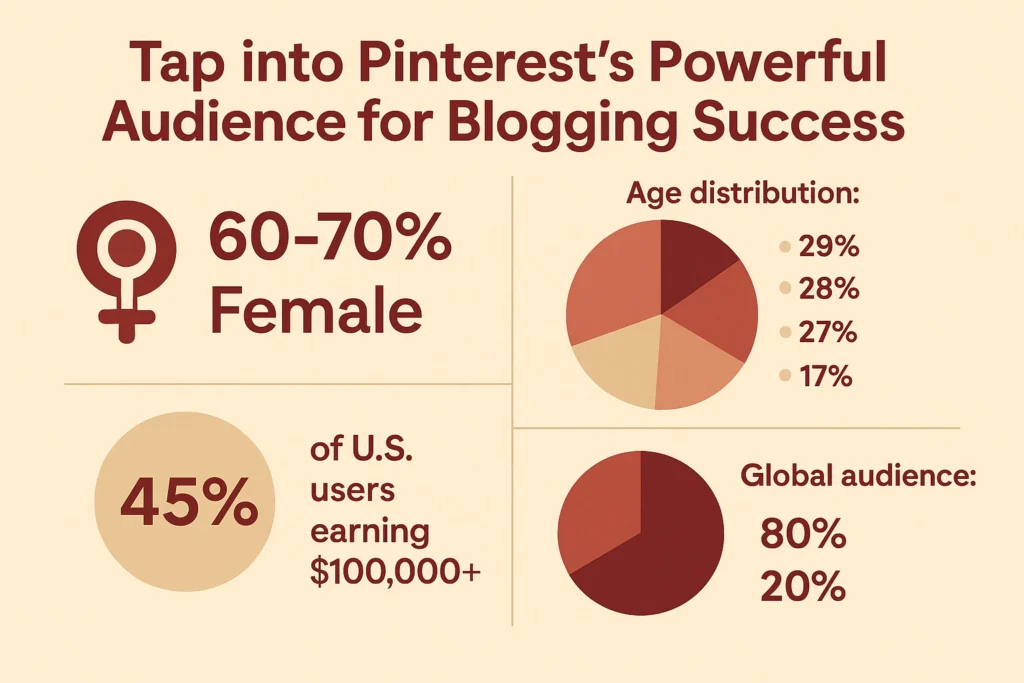
Knowing who uses Pinterest helps you tailor your Pinterest blogging content for maximum impact. According to recent data:
- 570 million monthly active users with a 10% year-over-year growth rate (Statista).
- Pinterest generates 1.3 billion website visits monthly (March 2024).
- Users visit the platform 2+ times per month on average.
- 60-70% female demographic, though male usership is growing.
- 45% of U.S. users earn $100,000+ annually.
- 80% use Pinterest to start new projects (high planning and purchase intent).
- 46% of weekly users discover new brands during searches.
- Pinterest ads deliver 2.3x more efficient cost-per-conversion than other social platforms.
These numbers highlight why Pinterest for Blogging is a critical channel for content creators aiming to increase visibility, connect with a well-defined audience, and drive long-term blog traffic.
How search intent drives traffic
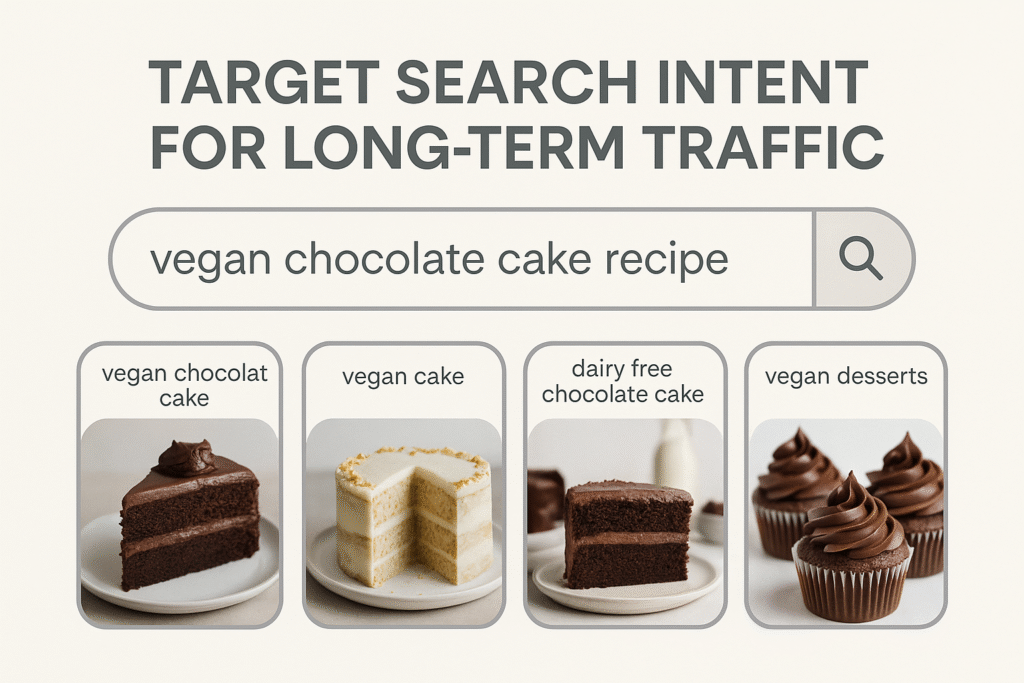
On Pinterest, users actively search with the intent to learn, plan, or purchase. Over 2 billion searches occur monthly on the platform, with 66% of users considering Pinterest their go-to platform for searches. This search-focused behavior translates directly to website traffic.
The platform’s visual search engine capabilities are particularly powerful. Pinterest’s Lens technology can identify objects in images and suggest related pins, making it a market leader in visual discovery. For Pinterest bloggers, this means that creating content that aligns with search intent is critical.
When someone types a query like “vegan chocolate cake recipe” into Pinterest’s search bar, the platform displays content that matches this intent based on:
- Keywords in pin titles and descriptions
- Image relevance and quality
- Board context and organization
- User engagement patterns
Pinterest’s algorithm assigns pins “annotations” (keywords between one and six words long) with confidence scores based on the quality of extracted information. This process helps match pins to relevant searches, subsequently driving targeted traffic to your blog.
The long lifespan of Pinterest content
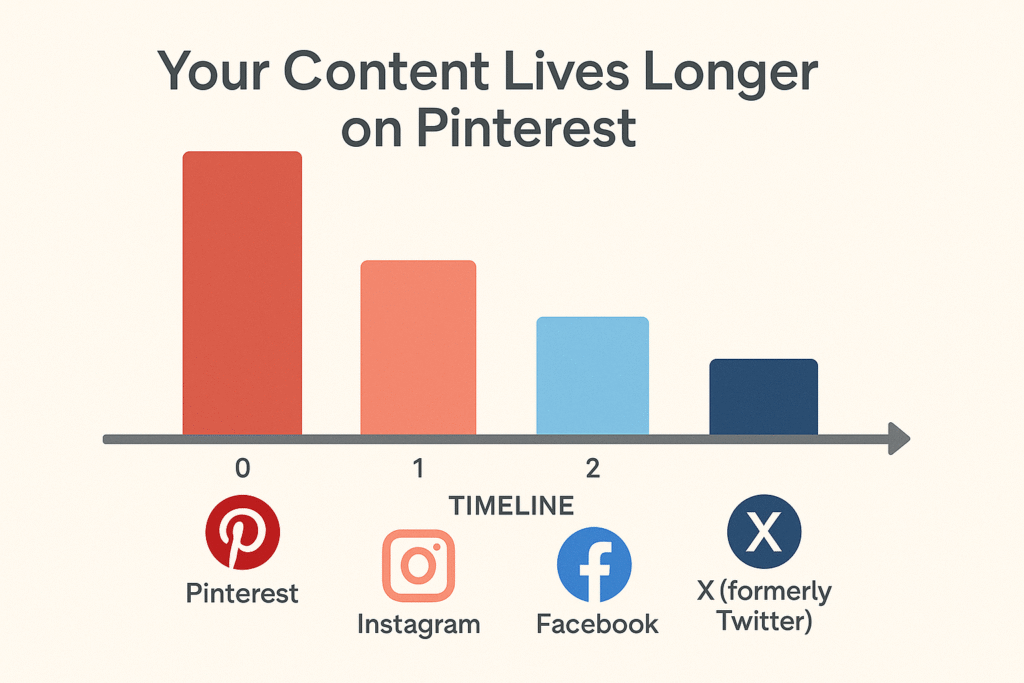
The most significant advantage of Pinterest for blogging comes from the extraordinary lifespan of pins. According to research, the average Pinterest pin has a half-life of 3.76 months, taking nearly four months to receive half of its total engagement. Facebook posts fade within five hours, and Instagram content lasts only 48 hours.
This extended visibility means pins drive blog traffic long after publication. Pinterest blogging content remains active for six to twelve months or even years, a stark departure from the fleeting visibility of traditional social media platforms.
Several factors contribute to this longevity:
- Pinterest’s search engine algorithm prioritizes relevance over recency
- Quality pins remain discoverable through relevant searches indefinitely
- Seasonal content resurfaces annually as related searches trend again
- The platform’s “catalog of ideas” approach preserves content value over time
For bloggers, this long lifespan creates a compounding effect where Pinterest marketing strategies continue working long after implementation. Old pins gain traction months after publishing, building passive traffic to blogs with minimal ongoing effort.
2. Set Up and Optimize Your Pinterest Profile
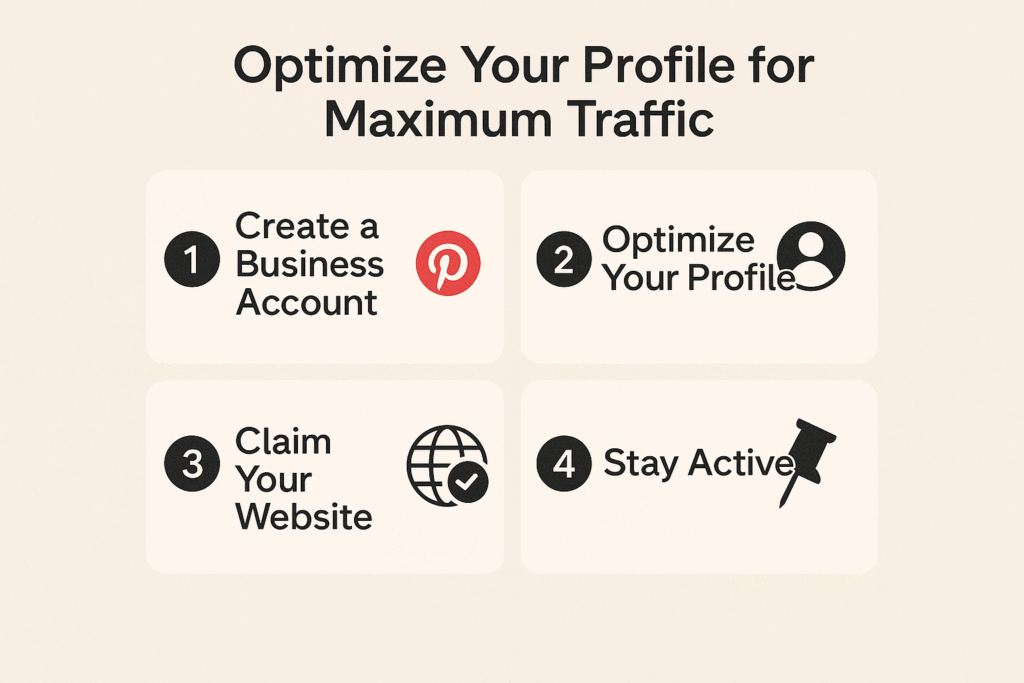
Success on Pinterest for Blogging starts with properly setting up your Pinterest profile. A well-optimized profile acts as your blog’s ambassador, helping Pinterest users discover your content and boosting your visibility in Pinterest search results.
Switch to a business account
Converting to a Pinterest business account unlocks powerful tools that personal accounts simply don’t offer. Business accounts provide access to Pinterest Analytics, the ability to run ads, and create rich pins, all essential features for bloggers serious about driving traffic.
Setting up a business account is straightforward:
- If you have an existing personal account, log in and click the dropdown menu in the top-right corner.
- Select “Settings” and then “Account management”.
- Find “Convert to a business account” and click “Convert account”.
- Complete your profile information, including business name and website URL.
For those starting fresh, visit pinterest.com/business/create and follow the signup prompts. Although possible on mobile devices, the desktop interface offers the most seamless setup experience.
Once converted, your Pinterest business account immediately grants access to valuable features like audience insights, performance metrics, and promotional tools. This transition preserves all your existing pins and followers while adding features designed for Pinterest content creators..
Claim your website and social accounts
Claiming your website on Pinterest establishes ownership and creates a powerful connection between your pins and blog. After verification, your Pinterest profile picture appears alongside any pin from your domain, even when shared by other Pinterest users. Additionally, a “Follow” button appears with these pins, increasing your follower acquisition opportunities and boosting Pinterest blogging visibility.
To claim your website:
- Go to Settings > Claimed accounts
- Select “Claim” next to Websites
- Choose your verification method (HTML tag, HTML file, or TXT record)
- Follow the verification steps provided
Pinterest offers three verification methods: adding an HTML tag to your site’s code, uploading an HTML file to your web server, or adding a TXT record to your DNS settings. For WordPress users, the HTML tag option typically proves easiest to implement.
Beyond your website, claiming your Instagram account enables cross-posting features. When properly connected, your Instagram content automatically generates Pinterest pins, extending your content’s reach across platforms. This integration maximizes traffic from Pinterest with minimal additional effort.
Write keyword-rich board descriptions
Board descriptions play a critical role in Pinterest SEO by providing context about your content. Pinterest’s algorithm uses these descriptions to understand what your pins represent and who might find them relevant in their Pinterest search.
Effective board descriptions follow a simple formula:
- Begin with your main keyword
- Explain what content users will find
- Describe who the board helps and what problem it solves
- Use natural, conversational language
For example, a yoga board description might read: “Yoga for beginners to help with weight loss, toning, flexibility, and stress. Learn Asana with video lessons, a morning and bedtime yoga routine, and how to do yoga poses as a beginner.”
Keep your board titles specific and keyword-focused rather than clever or vague. A title like “Budget Travel Tips for Southeast Asia” performs better than just “Southeast Asia” because it clearly signals content relevance to both users and the Pinterest blogging algorithm.
Use a clear profile image and bio
Your Pinterest profile image serves as your visual identity across the platform. For Pinterest bloggers, using a consistent personal photo rather than a logo often proves more effective, as it builds familiarity and trust. Make sure your Pinterest profile picture remains consistent across other social media platforms to strengthen brand recognition.
Craft your bio with SEO in mind, as Pinterest scans this text to understand your content focus. With only 160 characters available, prioritize clarity and relevance. An effective formula includes:
- Who you help
- How do you help them
- A clear call to action
Include your primary keywords 2–3 times naturally within your bio to improve Pinterest search discoverability. For your display name, consider adding your main keyword after your name (e.g., “Jane Smith | Budget Travel Tips”) to enhance Pinterest SEO further.
Unlike other platforms, Pinterest doesn’t recognize hashtags in profiles or board descriptions; instead, it relies on natural keyword integration throughout your Pinterest account. This approach aligns with its visual search engine functionality and improves your visibility to users searching for your content.
3. Create High-Performing Pins for Your Blog

Visually appealing pins drive more Pinterest traffic to your blog. The platform’s unique visual search engine functionality means your Pinterest pins need to stand out while also meeting specific Pinterest size and content requirements to perform well.
Use vertical images with a 2:3 ratio
Visual content on Pinterest thrives when formatted correctly. Vertical pins perform significantly better than horizontal or square images due to how users scroll through the platform. The recommended aspect ratio is 2:3 (width to height) or specifically 1000 x 1500 pixels. Pins exceeding this ratio might get truncated in feeds, potentially cutting off important information.
For video pins, a 9:16 aspect ratio (1080 x 1920 pixels) works best. This vertical orientation allows your Pinterest content to occupy more screen space as users scroll, increasing visibility and engagement.
Pinterest scales pin images to 238 pixels wide in Pinterest feeds, but users can view the full size by clicking. To maximize impact, use high-resolution images with good lighting and clean framing.
To know more about Pin dimensions and sizes, check out the RecurPost Pin Dimension article.
Design multiple pin variations per post
Creating multiple Pinterest pin designs for each blog post extends content reach. Pinterest for Blogging encourages this approach, stating: “It’s okay to have multiple Pins that land on the same destination. In fact, it’s good to save a variety of images that appeal to different types of people.”
Each variation should target different Pinterest audiences or highlight different aspects of your content. For example:
- Different headlines appealing to distinct reader segments
- Various visual styles (photos, graphics, text overlays)
- Seasonal or trending design elements
A simple formula for creating multiple pins is: 3 blog posts × 2 headline variations × 5 pin designs = 30 pins. This provides enough content to pin something fresh daily for a month.
When designing variations, maintain consistent Pinterest branding with the same fonts and colors. Track which pins perform best to replicate success patterns.
Add compelling titles and CTAs
Pinterest pin titles function like headlines that attract interest and encourage clicks. Effective titles include your target keywords near the beginning while offering clear value to readers.
Two effective title formulas include:
- Number + Adjective + Keyword + Promise (Example: “10 Must-See Landmarks in Paris That Will Leave You Breathless”)
- Trigger Word/Adjective + Keyword + Promise (Example: “Essential SEO Strategies for Boosting Your Website Traffic”)
Equally important, add clear calls-to-action (CTAs) to drive engagement. Pinterest recommends these depending on your goals:
- “Shop now” for product-focused content
- “Learn more” for educational content
- “Get recipe” for food-related pins
Other effective CTAs include “Grab the guide,” “Swipe the formula,” or “Download the [resource]”. These prompts direct action, increasing the likelihood of clicks to your blog.
Incorporate instructographics and rich pins
Instructographics, long, vertical images that guide users through step-by-step processes, are among Pinterest’s most shareable content types. These visual tutorials work excellently for how-to content, recipes, and DIY projects.
To create an instructographic:
- Capture images showing each step in your process
- Create a header image explaining what you’re demonstrating
- Combine the steps vertically with clear instructions
Also, implement Pinterest Rich Pins to add structured metadata to your Pinterest blogging strategy. There are three Rich Pin types:
- Article Rich Pins: Display your blog post’s title, author, and description
- Recipe Rich Pins: Show ingredients, cooking times, and serving sizes
- Product Rich Pins: Include pricing, availability, and ratings
Rich Pins stay consistent when repinned, maintaining your brand presence and content accuracy across the platform. If you update your blog post title or meta description, your Pinterest pins update automatically.
Setting up Rich Pins requires adding proper Pinterest metadata to your website, which can be implemented through WordPress plugins or manual code integration.
Here’s a code example for implementing Article Rich Pins manually if you don’t use WordPress:
<!-- Add this to your <head> section -->
<meta property="og:type" content="article" />4. Schedule and Automate Your Pinning Strategy
Consistent pinning drives successful Pinterest marketing strategies. After designing compelling pins, developing a system to post them regularly helps bloggers get results without being online every day, especially when managing Pinterest for Blogging at scale.
Use Pinterest’s native scheduler
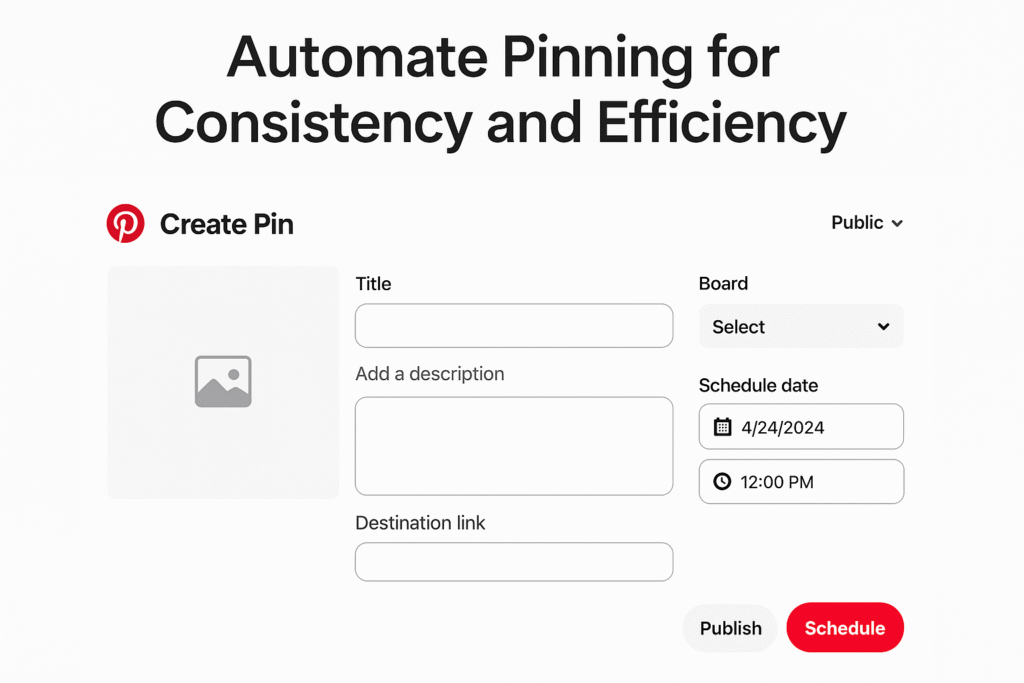
Pinterest offers a free built-in scheduler for business accounts, making it easy to plan ahead. To use this tool:
- Create a new pin as usual through the “Create” button.
- After adding your image, title, description, and destination link.
- Select “Publish at a later date” at the bottom of the page.
- Choose your preferred date and time.
- Click “Schedule” to finalize.
The native scheduler allows you to plan content up to 30 days in advance with a maximum of 100 scheduled pins at once. This tool works on both desktop and mobile devices, though desktop typically offers a smoother experience.
One significant limitation is that you cannot edit scheduled pins to make changes; you must delete and recreate them. Nevertheless, for bloggers just starting with Pinterest automation, the native scheduler provides an excellent no-cost entry point.
Try third-party tools like RecurPost
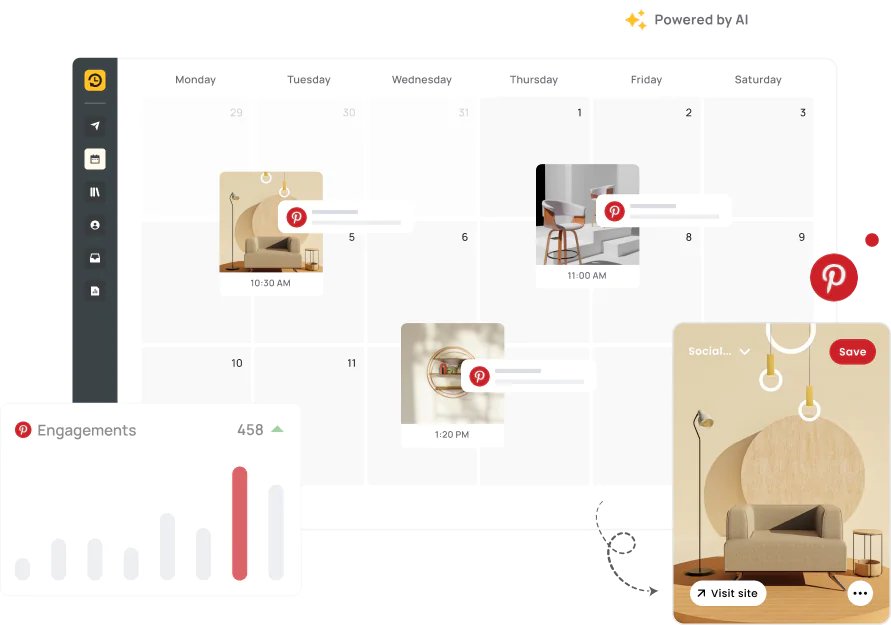
As your Pinterest content strategy grows, third-party tools like RecurPost offer advanced features beyond what Pinterest provides natively. RecurPost stands out by helping Pinterest bloggers stay consistent while saving time.
RecurPost allows you to:
- Schedule unlimited pins without the 30-day restriction.
- Upload up to 100 pins simultaneously via CSV or Google Sheets.
- Recycle high-performing content automatically.
- Manage multiple Pinterest accounts from one dashboard.
Its content recycling feature reshuffles top blog pins, giving them extended reach and driving more blog traffic. This is perfect for creators using Pinterest for Blogging who want more reach without repeating work.
Batch content creation and schedule weekly
Using a batching strategy is a time-saver on Pinterest for Blogging. Instead of creating and posting daily, set aside one day a week to do it all:
A typical batching workflow might include:
- Planning your content strategy (20-30 minutes).
- Creating multiple pin designs for each new blog post (30-40 minutes).
- Drafting compelling titles and descriptions (15-20 minutes).
- Scheduling everything at once (20-40 minutes).
One blogger reports completing her entire monthly Pinterest workflow in just 90 minutes using this approach, creating plans, executing designs, and scheduling everything in one focused session.
When batching, aim to schedule 1-2 pins daily for optimal results. This frequency maintains visibility without overwhelming followers or triggering Pinterest’s spam filters. Furthermore, diversify your content mix between blog posts, offers, and seasonal content to maximize engagement.
By implementing these scheduling and automation strategies, you’ll maintain a consistent Pinterest presence without the daily time investment. Subsequently, this allows you to focus on creating quality blog content while Pinterest works in the background, steadily driving traffic to your site.
5. Leverage Pinterest SEO and Trends
Pinterest marketing success depends on understanding how the platform handles search engine optimization. As a visual search engine, Pinterest relies heavily on keyword placement and trend relevance to get your Pinterest pins in front of the right audience, critical when growing with Pinterest for Blogging.
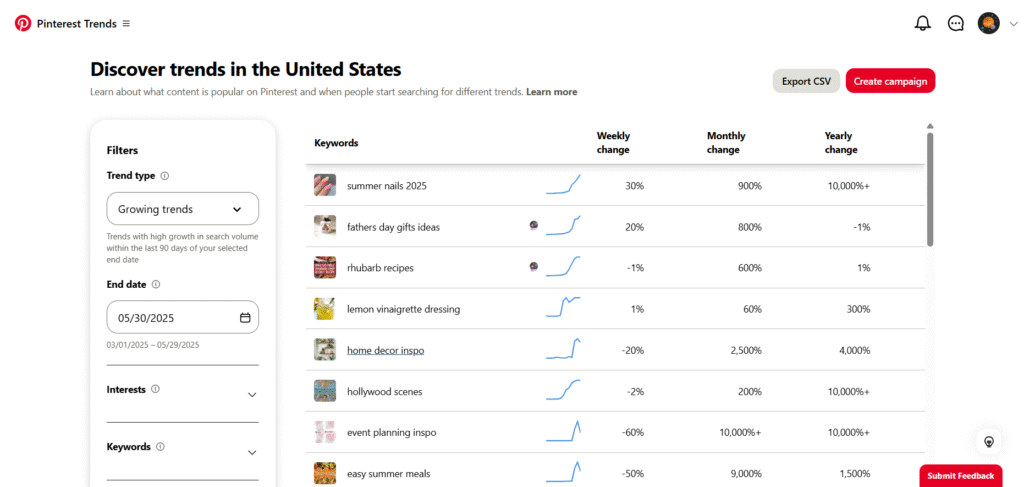
Research keywords using Pinterest Trends
Pinterest Trends serves as your primary keyword research tool, offering valuable insights into what users are actively searching for. To access this free tool, visit trends.pinterest.com. Through this platform, you can:
- Search for keywords relevant to your blog niche
- View normalized search volume data on interactive graphs
- Compare multiple search terms simultaneously
- Analyze demographic information by age and gender
When searching, use Pinterest’s search bar to uncover related suggestions; these are frequently searched phrases ordered by popularity. It’s ideal for Pinterest bloggers targeting long-tail keywords to increase visibility in less competitive areas.
Pinterest for Blogging content benefits greatly from focusing on niche-specific search intent, especially when using seasonal keywords surfaced by Pinterest Trends.
Optimize pin titles, descriptions, and file names
Every element of your pin presents an optimization opportunity. First, craft strategic pin titles using proven formulas:
- Number + Adjective + Keyword + Promise
(Example: “10 Must-See Landmarks in Paris That Will Leave You Breathless”) - Trigger Word/Adjective + Keyword + Promise
(Example: “Essential SEO Strategies for Boosting Your Website Traffic”)
Use your main Pinterest blogging keywords near the beginning of each title and again in your pin description. Write full sentences rather than keyword lists, and finish with a clear call-to-action (e.g., “Read more” or “Get the guide”).
Even file names matter. Rename image files like “IMG_0039.JPG” to something descriptive like “pinterest-content-calendar-2025.JPG”. Also, set alt text on each blog image; this becomes your pin description when users save images from your site.
Plan seasonal content in advance
On Pinterest, users begin searching for seasonal content months before they need it. Most importantly, pinners typically search three to six months ahead for seasonal ideas. To capitalize on this planning behavior:
- Create and post seasonal content at least six weeks before the actual holiday
- Ideally, publish three months in advance to allow Pinterest time to index your content
- Use Pinterest’s content calendar to identify upcoming trends and themes
For instance, in February, you should already be pinning content related to spring outfits, spring cleaning, gardening, and St. Patrick’s Day. By June, start preparing Christmas-related pins.
This advanced planning gives your seasonal content time to build engagement history, making it more likely to appear in search results during peak seasons. Furthermore, Pinterest’s yearly content calendar provides monthly themes and weekly focuses to inspire your content planning throughout the year.
6. Track Performance and Refine Your Strategy
Tracking Pinterest performance reveals what resonates with audiences. Analysis adjusts strategies based on actual user behavior rather than assumptions.
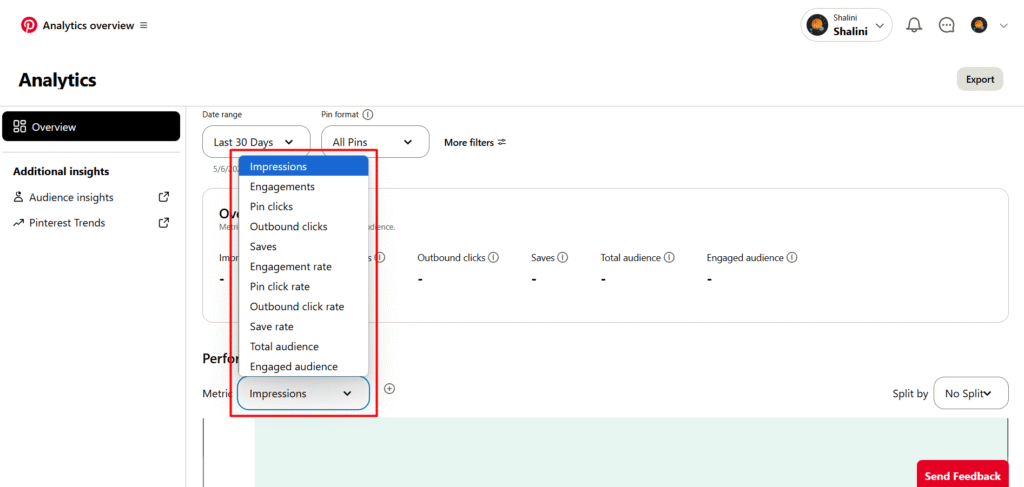
Use Pinterest Analytics to monitor top pins
Pinterest Analytics gives you a clear dashboard of how your Pinterest business account performs. To access it, log in and go to Analytics Overview in the top-left menu. You’ll see your top-performing pins and boards from the last 30 days.
Start by identifying which Pinterest pins drive the most engagement. Use the dropdown to sort pins by impressions, clicks, or saves. This shows what types of Pinterest content resonate with your audience and what’s worth creating more of.
Measure saves, clicks, and conversions
Several key metrics reveal different aspects of your content’s performance:
- Impressions – The number of times your pins appear on screen
- Saves – How many users add your pin to their Pinterest boards, indicating content value
- Pin clicks – Total clicks on your pin to view it in detail
- Outbound clicks – Users who click through to your website
Certainly, conversion metrics deserve special attention. The Conversion Insights tool helps understand how pins influence revenue and other business goals. This dashboard shows which pins lead to conversions and lets you sort by checkouts, page visits, or add-to-cart actions
Adjust pin designs and posting times based on data
Upon identifying patterns in your top-performing content, use these insights to refine your approach. If certain visual styles or topics consistently outperform others, create more similar content. This might involve adjusting colors, text placement, or image styles based on what generates the most engagement.
Similarly, analyze when your audience is most active. In Pinterest Analytics, check the “Engaged Audience” report to see when followers interact most with your posts. Most research indicates 8:00 PM to 9:00 PM tends to be peak engagement time; however your specific audience might differ.
Additionally, experiment with different pinning schedules and track engagement. Small changes in timing or design can yield big traffic improvements over time, especially when you’re committed to long-term success with Pinterest for Blogging.
Pinterest can become your blog’s secret weapon in 2025. Success requires smart SEO, captivating visuals, and consistency.
A tool like RecurPost automates and maintains consistency, keeping content visible and discoverable. Start pinning with a purpose to increase blog traffic. What’s the first pin you’ll schedule with RecurPost?
FAQs on Pinterest Blogging
1. Can I use Pinterest for affiliate marketing directly, or do I always need a blog post in between?
Yes, you can directly link to affiliate products on Pinterest! However, you must disclose your affiliate relationship in your pin description, following FTC guidelines. Some programs may restrict direct linking, so check your affiliate terms. That said, many Pinterest bloggers use a blog post as the bridge between Pinterest and product links to provide context and increase trust.
2. What’s the absolute best time to post on Pinterest in 2025?
While general recommendations suggest evenings (around 8 PM to 11 PM IST for your location) and weekends often perform well, your audience is unique. The best way to find your sweet spot is to check your Pinterest Analytics for when your specific followers are most active and experiment with different times.
3. Are there any special considerations for selling products, like from an Etsy shop, on Pinterest?
Definitely! Use Product Rich Pins to automatically display real-time pricing and availability. Make sure your Pinterest pins are high-quality product images, and include keywords your customers are likely to search. For a Pinterest blogging strategy, this method blends product sales with valuable content.
4. Can Idea Pins make me money on Pinterest?
Pinterest Idea Pins don’t have direct outbound links on each page, so they don’t directly drive traffic in the same way regular pins do. However, they’re fantastic for building brand awareness, showcasing your expertise, and engaging your audience, which can indirectly lead to blog traffic and monetization. Think of them as a compelling preview that encourages viewers to check out your blog board for more.
To get an overview of how to make money on Pinterest, visit our guide here.
5. What should I avoid doing on Pinterest to make sure my account stays in good standing?
Avoid spamming, don’t repeat the same Pinterest pin across dozens of boards. Focus on fresh content with valuable insights. Also, don’t copy other people’s Pinterest images or descriptions. Stick to original, helpful content that aligns with Pinterest search guidelines to protect your account.
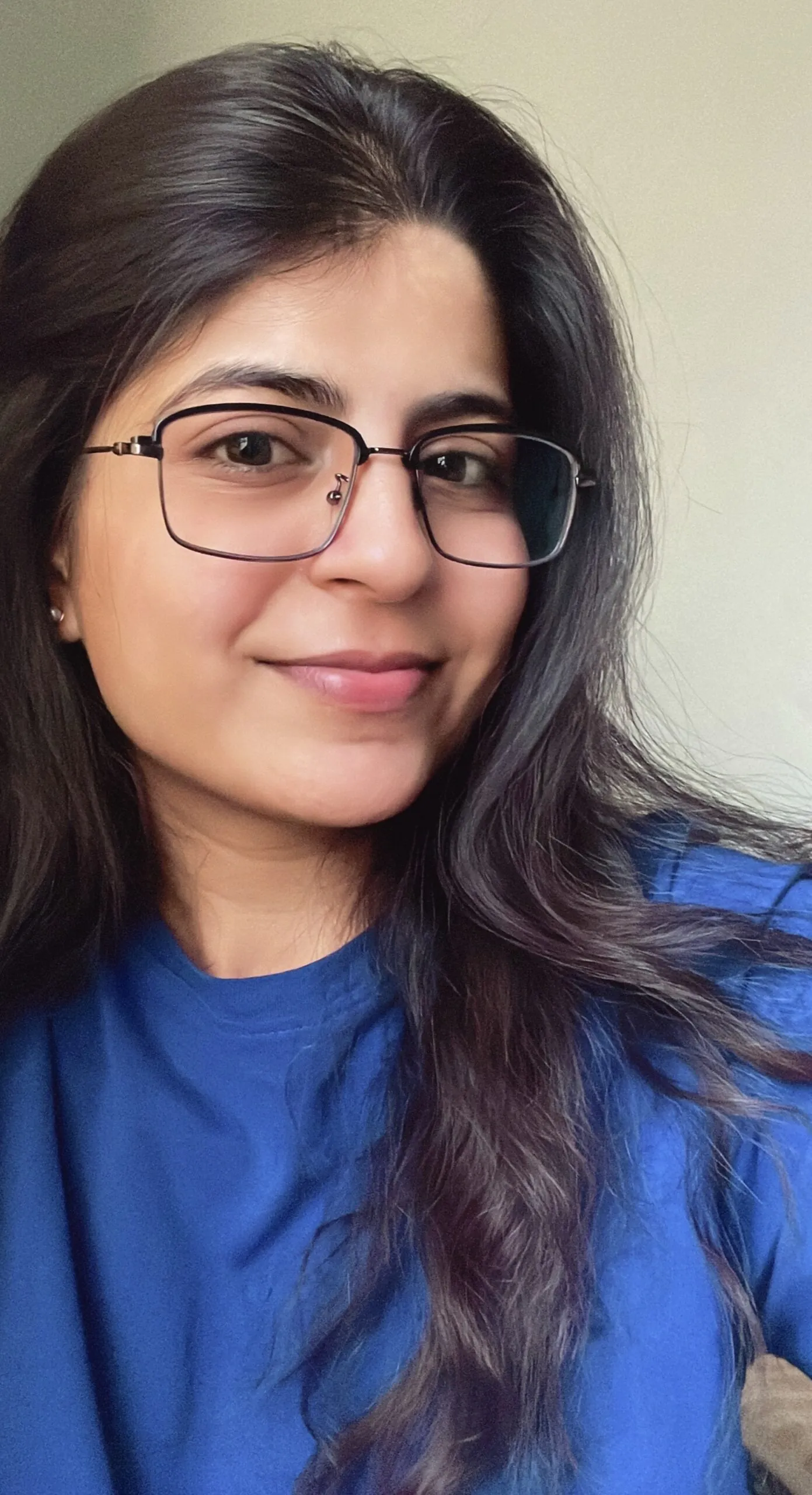
Shalini Nagar is an experienced content writer with a proven track record of creating diverse and engaging content across various formats. With years of expertise in crafting blogs, articles, she excels at delivering compelling narratives tailored to different audiences.

